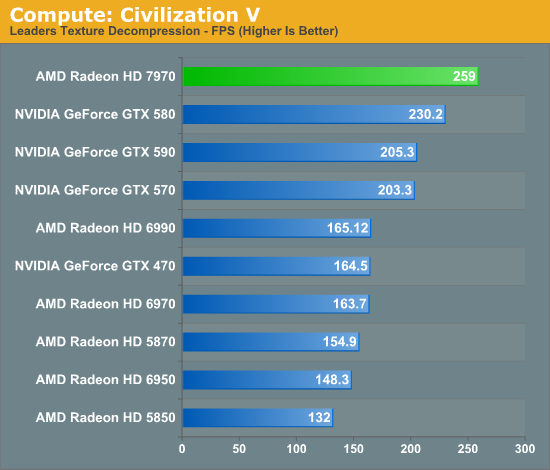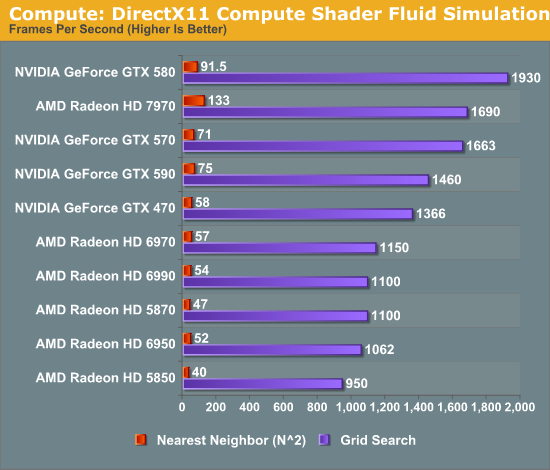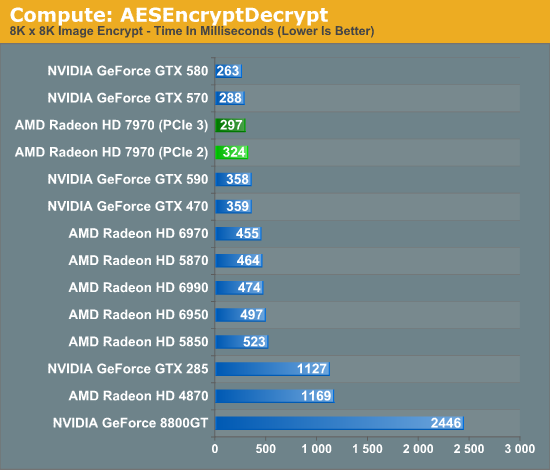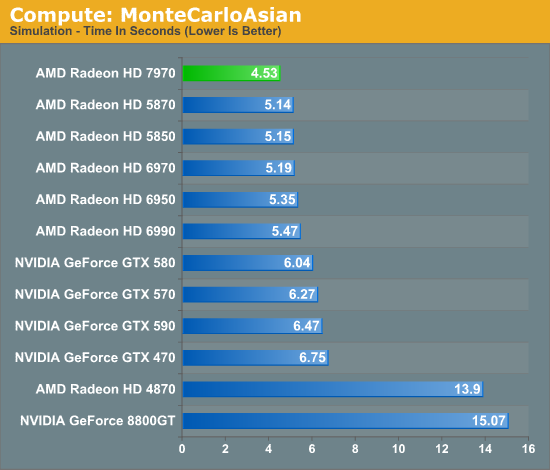AMD Radeon HD 7970 Review: 28nm And Graphics Core Next, Together As One
by Ryan Smith on December 22, 2011 12:00 AM EST- Posted in
- GPUs
- AMD
- Radeon
- ATI
- Radeon HD 7000
Compute: The Real Reason for GCN
Moving on from our game tests we’ve now reached the compute benchmark segment of our review. While the gaming performance of the 7970 will have the most immediate ramifications for AMD and the product, it is the compute performance that I believe is the more important metric in the long run. GCN is both a gaming and a compute architecture, and while its gaming pedigree is well defined its real-world compute capabilities still need to be exposed.
With that said, we’re going to open up this section with a rather straightforward statement: the current selection of compute applications for AMD GPUs is extremely poor. This is especially true for anything that would be suitable as a benchmark. Perhaps this is because developers ignored Evergreen and Northern Islands due to their low compute performance, or perhaps this is because developers still haven’t warmed up to OpenCL, but here at the tail end of 2011 there just aren’t very many applications that can make meaningful use of the pure compute capabilities of AMD’s GPUs.
Aggravating this some is that of the applications that can use AMD’s compute capabilities, some of the most popular ones among them have been hand-tuned for AMD’s previous architectures to the point that they simply will not run on Tahiti right now. Folding@Home, FLACC, and a few other candidates we looked into for use as compute benchmarks all fall under this umbrella, and as a result we only have a limited toolset to work with for proving the compute performance of GCN.
So with that out of the way, let’s get started.
Since we just ended with Civilization V as a gaming benchmark, let’s start with Civilization V as a compute benchmark. We’ve seen Civilization V’s performance skyrocket on 7970 and we’ve theorized that it’s due to improvements in compute shader performance, and now we have a chance to prove it.

And there’s our proof. Compared to the 6970, the 7970’s performance on this benchmark has jumped up by 58%, and even the previously leading GTX 580 is now beneath the 7970 by 12%. GCN’s compute ambitions are clearly paying off, and in the case of Civilization V it’s even enough to dethrone NVIDIA entirely. If you’re AMD there’s not much more you can ask for.
Our next benchmark is SmallLuxGPU, the GPU ray tracing branch of the open source LuxRender renderer. We’re now using a development build from the version 2.0 branch, and we’ve moved on to a more complex scene that hopefully will provide a greater challenge to our GPUs.

Again the 7970 does incredibly well here compared to AMD’s past architectures. AMD already did rather well here even with the limited compute performance of their VLIW4 architecture, and with GCN AMD once again puts their old architectures to shame, and puts NVIDIA to shame too in the process. Among single-GPU cards the GTX 580 is the closest competitor and even then the 7970 leads it by 72%. The story is much the same for the 7970 versus the 6970, where the 7970 leads by 74%. If AMD can continue to deliver on performance gains like these, the GCN is going to be a formidable force in the HPC market when it eventually makes its way there.
For our next benchmark we’re once again looking at compute shader performance, this time through the Fluid simulation sample in the DirectX SDK. This program simulates the motion and interactions of a 16k particle fluid using a compute shader, with a choice of several different algorithms. In this case we’re using two of them: a highly optimized grid search that Microsoft based on an earlier CUDA implementation, and an (O)n^2 nearest neighbor method that is optimized by using shared memory to cache data.

There are many things we can gather from this data, but let’s address the most important conclusions first. Regardless of the algorithm used, AMD’s VLIW4 and VLIW5 architectures had relatively poor performance in this simulation; NVIDIA meanwhile has strong performance with the grid search algorithm, but more limited performance with the shared memory algorithm. 7970 consequently manages to blow away the 6970 in all cases, and while it can’t beat the GTX 580 at the grid search algorithm it is 45% faster than the GTX 580 with the shared memory algorithm.
With GCN AMD put a lot of effort into compute performance, not only with respect to their shader/compute hardware, but with the caches and shared memory to feed that hardware. I don’t believe we have enough data to say anything definitive about how Tahiti/GCN’s cache compares to Fermi’s cache, this benchmark does raise the possibility that GCN cache design is better suited for less than optimal brute force algorithms. In which case what this means for AMD could be huge, as it could open up new HPC market opportunities for them that NVIDIA could never access, and certainly it could help AMD steal market share from NVIDIA.
Moving on to our final two benchmarks, we’ve gone spelunking through AMD’s OpenCL archive to dig up a couple more compute scenarios to use to evaluate GCN. The first of these is AESEncryptDecrypt, an OpenCL AES encryption routine that AES encrypts/decrypts an 8K x 8K pixel square image file. The results of this benchmark are the average time to encrypt the image over a number of iterations of the AES cypher.

We went into the AMD OpenCL sample archives knowing that the projects in it were likely already well suited for AMD’s previous architectures, and there is definitely a degree of that in our results. The 6970 already performs decently in this benchmark and ultimately the GTX 580 is the top competitor. However the 7970 still manages to improve on the 6970 by a sizable degree, and accomplishes this encryption task in only 65% the time. Meanwhile compared to the GTX 580 it trails by roughly 12%, which shows that if nothing else Fermi and GCN are going to have their own architectural strengths and weaknesses, although there’s obviously some room for improvement.
One interesting fact we gathered from this compute benchmark is that it benefitted from the increase in bandwidth offered by PCI Express 3.0. With PCIe 3.0 the 7970 improves by about 10%, showcasing just how important transport bandwidth is for some compute tasks. Ultimately we’ll reach a point where even games will be able to take full advantage of PCIe 3.0, but for right now it’s the compute uses that will benefit the most.
Our final benchmark also comes from the AMD OpenCL archives, and it’s a variant of the Monte Carlo method implemented in OpenCL. Here we’re timing how long it takes to execute a 400 step simulation.

For our final benchmark the 7970 once again takes the lead. The rest of the Radeon pack is close behind so GCN isn’t providing an immense benefit here, but AMD still improves upon the 6970 by 14%. Meanwhile the lead over the GTX 580 is larger at 33%.
Ultimately from these benchmarks it’s clear that AMD is capable of delivering on at least some of the theoretical potential for compute performance that GCN brings to the table. Not unlike gaming performance this is often going to depend on the task at hand, but the performance here proves that in the right scenario Tahiti is a very capable compute GPU. Will it be enough to make a run at NVIDIA’s domination with Tesla? At this point it’s too early to tell, but the potential is there, which is much more than we could say about VLIW4.










292 Comments
View All Comments
CeriseCogburn - Sunday, March 11, 2012 - link
We'll have to see if amd "magically changes that number and informs Anand it was wrong like they did concerning their failed recent cpu.... LOLThat's a whole YEAR of lying to everyone trying to make their cpu look better than it's actual fail, and Anand shamefully chose to announce the number change "with no explanation given by amd"... -
That's why you should be cautious - we might find out the transistor count is really 33% different a year from now.
piroroadkill - Thursday, December 22, 2011 - link
Only disappointing if you:a) ignored the entire review
b) looked at only the chart for noise
c) have brain damage
Finally - Thursday, December 22, 2011 - link
In Eyefinity setups the new generation shines: http://tinyurl.com/bu3wb5cwicko - Thursday, December 22, 2011 - link
I think the price is disappointing. Everything else is nice though.CeriseCogburn - Sunday, March 11, 2012 - link
The drivers suckRussianSensation - Thursday, December 22, 2011 - link
Not necessarily. The other possibility is that being 37% better on average at 1080P (from this Review) over HD6970 for $320 more than an HD6950 2GB that can unlock into a 6970 just isn't impressive enough. That should be d).piroroadkill - Friday, December 23, 2011 - link
Well, I of course have a 6950 2GB that unlocked, so as far as I'm concerned, that has been THE choice since the launch of the 6950, and still is today.But you have to ignore cost at launch, it's always high.
CeriseCogburn - Thursday, March 8, 2012 - link
I agree RS, as these amd people are constantly screaming price percentage increase vs performance increase... yet suddenly applying the exact combo they use as a weapon against Nvidia to themselves is forbidden, frowned upon, discounted, and called unfair....Worse yet, according to the same its' all Nvidia's fault now - that amd is overpriced through the roof...LOL - I have to laugh.
Also, the image quality page in the review was so biased toward amd that I thought I was going to puke.
Amd is geven credit for a "perfect algorythm" that this very website has often and for quite some time declared makes absolutely no real world difference in games - and in fact, this very reviewer admitted the 1+ year long amd failure in this area as soon as they released "the fix" - yet argued everyone else was wrong for the prior year.
The same thing appears here.
Today we find out the GTX580 nvidia card has much superior anti-shimmering than all prior amd cards, and that finally, the 7000 high end driver has addressed the terrible amd shimmering....
Worse yet, the decrepit amd low quality impaired screens are allowed in every bench, with the 10% amd performance cheat this very site outlined them merely stated we hope Nvidia doesn't so this too - then allowed it, since that year plus ago...
In the case of all the above, I certainly hope the high end 797x cards aren't CHEATING LIKE HECK still.
For cripe sakes, get the AA stuff going, stop the 10% IQ cheating, and get our bullet physics or pay for PhysX, and stabilize the drivers .... I am sick of seeing praise for cheating and failures - if they are (amd) so great let's GET IT UP TO EQUIVALENCY !
Wow I'm so mad I don't have a 7970 as supply is short and I want to believe in amd for once... FOR THE LOVE OF GOD DID THEY GET IT RIGHT THIS TIME ?!!?
slayernine - Thursday, December 22, 2011 - link
Holy fan boys batman!This comment thread reeks of nvidia fans green with jealousy
Hauk - Thursday, December 22, 2011 - link
LOL, Wreckage first!Love him or hate him, he's got style..